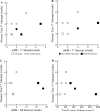Minimal forced use without constraint stimulates spontaneous use of the impaired upper extremity following motor cortex injury
- PMID: 20107980
- PMCID: PMC3650615
- DOI: 10.1007/s00221-010-2157-y
Minimal forced use without constraint stimulates spontaneous use of the impaired upper extremity following motor cortex injury
Abstract
The purpose of this study was to determine if recovery of neurologically impaired hand function following isolated motor cortex injury would occur without constraint of the non-impaired limb, and without daily forced use of the impaired limb. Nine monkeys (Macaca mulatta) received neurosurgical lesions of various extents to arm representations of motor cortex in the hemisphere contralateral to the preferred hand. After the lesion, no physical constraints were placed on the ipsilesional arm/hand and motor testing was carried out weekly with a maximum of 40 attempts in two fine motor tasks that required use of the contralesional hand for successful food acquisition. These motor tests were the only "forced use" of the contralesional hand. We also tested regularly for spontaneous use of the contralesional hand in a fine motor task in which either hand could be used for successful performance. This minimal intervention was sufficient to induce recovery of the contralesional hand to such a functional level that eight of the monkeys chose to use that hand on some trials when either hand could be used. Percentage use of the contralesional hand (in the task when either hand could be used) varied considerably among monkeys and was not related to lesion volume or recovery of motor skill. These data demonstrate a remarkable capacity for recovery of spontaneous use of the impaired hand following localized frontal lobe lesions. Clinically, these observations underscore the importance of therapeutic intervention to inhibit the induction of the learned nonuse phenomenon after neurological injury.
Figures




Similar articles
-
Functional recovery following motor cortex lesions in non-human primates: experimental implications for human stroke patients.J Integr Neurosci. 2011 Sep;10(3):353-84. doi: 10.1142/S0219635211002737. J Integr Neurosci. 2011. PMID: 21960307 Free PMC article. Review.
-
Long-term forced-use therapy after sensorimotor cortex lesions restores contralesional hand function and promotes its preference in Macaca mulatta.Exp Brain Res. 2024 Dec 28;243(1):35. doi: 10.1007/s00221-024-06949-x. Exp Brain Res. 2024. PMID: 39731617
-
Volumetric effects of motor cortex injury on recovery of ipsilesional dexterous movements.Exp Neurol. 2011 Sep;231(1):56-71. doi: 10.1016/j.expneurol.2011.05.015. Epub 2011 Jun 15. Exp Neurol. 2011. PMID: 21703261 Free PMC article.
-
Recovery of precision grasping after motor cortex lesion does not require forced use of the impaired hand in Macaca mulatta.Exp Brain Res. 2014 Dec;232(12):3929-38. doi: 10.1007/s00221-014-4068-9. Epub 2014 Aug 28. Exp Brain Res. 2014. PMID: 25163672 Free PMC article.
-
Training-induced recovery of manual dexterity after a lesion in the motor cortex.Keio J Med. 2010;59(1):4-9. doi: 10.2302/kjm.59.4. Keio J Med. 2010. PMID: 20375652 Review.
Cited by
-
Functional recovery following motor cortex lesions in non-human primates: experimental implications for human stroke patients.J Integr Neurosci. 2011 Sep;10(3):353-84. doi: 10.1142/S0219635211002737. J Integr Neurosci. 2011. PMID: 21960307 Free PMC article. Review.
-
Behavioral assessment of manual dexterity in non-human primates.J Vis Exp. 2011 Nov 11;(57):3258. doi: 10.3791/3258. J Vis Exp. 2011. PMID: 22105161 Free PMC article.
-
Greater Reduction in Contralesional Hand Use After Frontoparietal Than Frontal Motor Cortex Lesions in Macaca mulatta.Front Syst Neurosci. 2021 Mar 18;15:592235. doi: 10.3389/fnsys.2021.592235. eCollection 2021. Front Syst Neurosci. 2021. PMID: 33815072 Free PMC article.
-
Hand Motor Recovery Following Extensive Frontoparietal Cortical Injury Is Accompanied by Upregulated Corticoreticular Projections in Monkey.J Neurosci. 2018 Jul 11;38(28):6323-6339. doi: 10.1523/JNEUROSCI.0403-18.2018. Epub 2018 Jun 13. J Neurosci. 2018. PMID: 29899028 Free PMC article.
-
Long-term forced-use therapy after sensorimotor cortex lesions restores contralesional hand function and promotes its preference in Macaca mulatta.Exp Brain Res. 2024 Dec 28;243(1):35. doi: 10.1007/s00221-024-06949-x. Exp Brain Res. 2024. PMID: 39731617
References
-
- Brogardh C, Vestling M, Sjolund BH. Shortened constraint-induced movement therapy in subacute stroke–no effect of using a restraint: a randomized controlled study with independent observers. J Rehabil Med. 2009;41:231–236. - PubMed
-
- Chamoun RB, Mikati MA, Comair YG. Functional recovery following resection of an epileptogenic focus in the motor hand area. Epilepsy Behav. 2007;11:384–388. - PubMed
-
- Crocker MD, MacKay-Lyons M, McDonnell E. Forced use of the upper extremity in cerebral palsy: a single-case design. Am J Occup Ther. 1997;51:824–833. - PubMed
-
- Darling WG, Peterson CR, Herrick JL, McNeal DW, Stilwell-More-craft KS, Morecraft RJ. Measurement of coordination of object manipulation in non-human primates. J Neurosci Methods. 2006;154:38–44. - PubMed
Publication types
MeSH terms
Grants and funding
LinkOut - more resources
Full Text Sources

